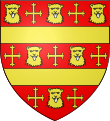
House of Godwin
Anglo-Saxon dynasty / From Wikipedia, the free encyclopedia
Dear Wikiwand AI, let's keep it short by simply answering these key questions:
Can you list the top facts and stats about House of Godwin?
Summarize this article for a 10 year old
The House of Godwin (Old English: Godƿin) is an Anglo-Saxon family who were one of the leading noble families in England during the last fifty years before the Norman Conquest. Its most famous member was Harold Godwinson, King of England for nine months in 1066.
| House of Godwin | |
|---|---|
| Royal and princely house | |
 This modern representation of arms of King Harold II is one of several coats of arms attributed to the House of Godwin. Similar arms are displayed in Winchester Castle. | |
| Parent family | House of Wessex (?) |
| Place of origin | Sussex |
| Founder | Godwin, Earl of Wessex |
| Final ruler | Harold II (England, 1066) Inge II (Norway, 1217) |
| Titles | |
| Cadet branches | Rein dynasty Torgar dynasty |
The founder of the family's greatness, Earl Godwin, was raised from comparative obscurity by King Cnut and given the Earldom of Wessex c. 1018-1019. He retained his position during the reigns of Cnut's sons Harold Harefoot and Harthacnut, and consolidated it when King Edward the Confessor conferred earldoms on Sweyn and Harold, Godwin's two eldest sons by his Danish wife Gytha.
The family survived a short-lived exile in Flanders 1051-1052. After Godwin's death in 1053, his sons held the earldoms of Wessex, East Anglia, and later Northumbria; Harold, in particular, became the most powerful man in England, eclipsing the power of the king. When Edward the Confessor died childless in 1066, he was succeeded by Harold Godwinson.
Harold gained a great victory over the Norwegian king Harald Hardrada and his own estranged brother Tostig Godwinson at the Battle of Stamford Bridge. Three weeks later, with his defeat and death at the Battle of Hastings, Anglo-Saxon self-rule came to an end. Later generations of the family were scattered around Northern Europe. Through female lines, the Godwin family are ancestors of royal houses across Europe, including the Grand Princes of Kiev.[1][2][3]
Patrilineally, agnates of the House of Godwin have lived in Norway since 1067, where they belonged to the kingdom's greatest aristocratic dynasties. King Olaf III of Norway installed Skule Kongsfostre, an older son or stepson of Earl Tostig, at the Rein estate in Trøndelag (Central Norway), establishing the Rein dynasty. Among his descendants were King Inge II of Norway and Duke Skule Bårdsson.
Earl Tostig's younger son, Ketil Hook, was given the Torgar estate in Hålogaland (Northern Norway) and married a granddaughter of chieftain Hárek of Tjøtta, establishing the younger Torgar dynasty. Finally, King Harold Godwinson's son Harold Haroldson joined the retinue of King Magnus III of Norway; his descendants may have been the many Godwins who appear in Eastern Norway from the early 13th century.
As earls, that is, quasi-sovereign princes, the family has maintained its own nobility or retinue, including housecarls. The family's vassals include the kings of Gwynedd (Wales).
Oops something went wrong: